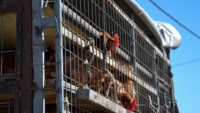The risk of microbial growth increases with the use of high-pressure production processes of meat, according to a new scientific opinion published by the European Food Safety Authority (EFSA) on public health risks related to mechanically separated meat. EFSA’s Panel on Biological Hazards (BIOHAZ) also developed a model to help identify mechanically separated meat and differentiate it from other types of meat.
Mechanically separated meat is derived from the meat left on animal carcasses once the main cuts have been removed. This meat can be mechanically removed and used in other foods.
EFSA’s opinion concluded that possible microbiological risks associated with mechanically separated meat are similar to those related to non-mechanically separated meat. Microbiological and chemical risks arise from the contamination of raw materials and from poor hygiene practices during meat processing. However, high-pressure production processes increase the risk of microbial growth. In fact these processes result in greater muscle fiber degradation and an associated release of nutrients which provide a favorable substrate for bacterial growth.
BIOHAZ considered different parameters to distinguish mechanically separated meat from non-mechanically separated meat, finding that, based on currently available data, calcium (released from bone during processing) is the most appropriate chemical parameter. EFSA’s scientific experts developed a model which uses calcium levels to support the identification of mechanically separated meat products. The model will assist policymakers, as well as food operators and inspectors in differentiating mechanically separated meat from non-mechanically separated meat.
In order to improve the differentiation between mechanically separated meat obtained through low-pressure techniques and hand deboned meat, EFSA recommends the use of specifically designed studies to collect data on potential indicators.
Get our eMagazine delivered directly to your inbox
Stay in the know on the latest science-based solutions for food safety.
SUBSCRIBE TODAY!Copyright ©2024. All Rights Reserved BNP Media.
Design, CMS, Hosting & Web Development :: ePublishing



